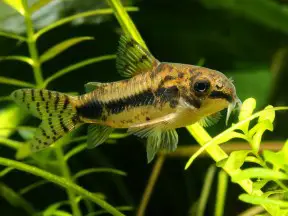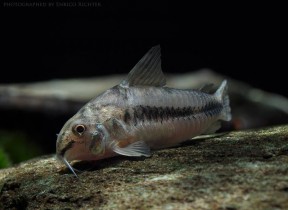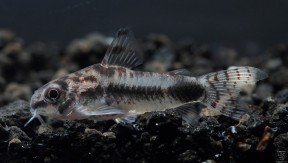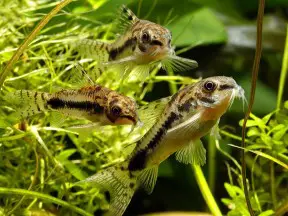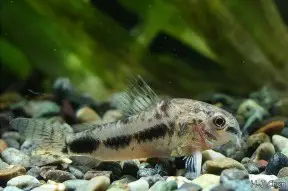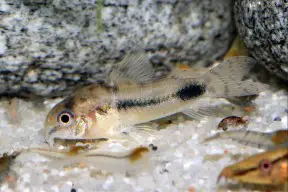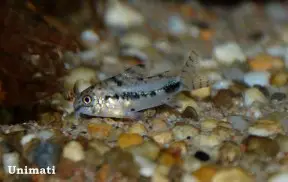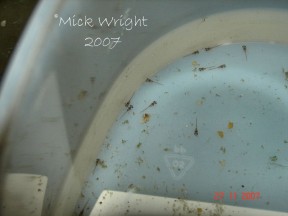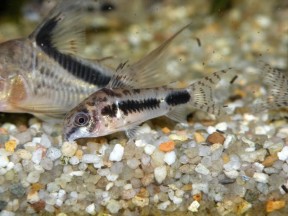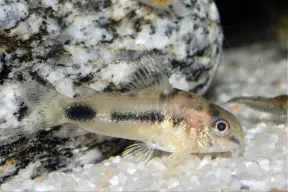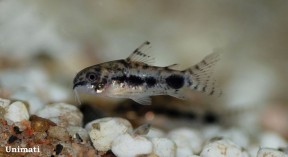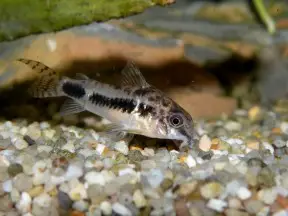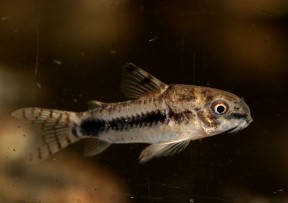Corydoras habrosus
Salt and Pepper Cory
Etymology
Corydoras: from the Ancient Greek κόρυς (korus), meaning ‘helmet’, and δορά (dora), meaning ‘skin, hide of an animal’, in allusion to the rows of bony plates on the flanks of genus members.
habrosus: from the Ancient Greek ἁβρός (habrós), meaning ‘graceful, delicate’.
Classification
Order: Siluriformes Family: Callichthyidae
Distribution
Native to the upper Río Orinoco basin in eastern Colombia and western Venezuela, where it appears to be restricted to left bank tributaries.
The majority of records derive from the Río Apure watershed in southwestern Venezuela, where C. habrosus has been collected in the states of Portuguesa, Cojedes, Barinas, Guárico, and Apure. Its distribution in Colombia is less clear but it is known with certainty from the Río Arauca and Río Casanare, the latter a tributary of the lower Río Meta, and it makes sense that it should also be found in other left bank Orinoco affluents between the Meta and Apure, which include the ríos Cinaruco and Capanaparo.
Type locality is ‘Río Salinas, tributary of Río Pao Viejo, El Baúl, 8°59’N, 68°16’W, Cojedes, Venezuela’.
Habitat
This species occurs in the Llanos Orientales region, a vast tropical grassland plain traversed by the Orinoco and some of its major left bank tributaries. Large swathes of these plains become flooded during the annual wet season, forming an enormous wetland which is a paradise for wildlife.
C. habrosus apparently displays a preference for lagoons, tributary streams, inundated forest and grassland, and marginal zones, where water flow is not strong. It tends to form aggregations close to submerged vegetation or solid structures such as tree branches or roots.
Other fishes occurring in the region and available in the aquarium trade include Corydoras delphax, Platydoras costatus, Baryancistrus beggini, Hypancistrus inspector, Panaqolus maccus, Panaque nigrolineatus, Hemigrammus rhodostomus, H. stictus, Hyphessobrycon sweglesi, Paracheirodon axelrodi, Pristella maxillaris, Copella nattereri, Biotodoma wavrini, Heros severus, Mesonauta insignis, Geophagus abalios, Satanoperca daemon and Uaru fernandezyepezi.
Maximum Standard Length
30 – 35 mm.
Aquarium SizeTop ↑
Minimum base dimensi0ns of 60 ∗ 30 cm are recommended. This species is unsuitable for modern ‘nano’ aquaria.
Maintenance
Ideally use a substrate of fine sand, although rounded gravel is an acceptable alternative provided that it is kept scrupulously clean.
Other décor is largely down to personal choice, but some cover should be provided to give the fish security.
Water Conditions
Temperature: 20 – 26 °C
pH: 5.5 – 7.5
Hardness: 36 – 179 ppm
Diet
Corydoras spp. are foraging omnivores, and most will accept sinking dried foods as well as small live and frozen varieties such as chironomid larvae (bloodworm), Tubifex, etc.
Feeding a varied diet will ensure the fish are in optimum condition.
Under no circumstances should they be expected to survive on ‘left-overs’ from other inhabitants of the aquarium or relied on to ‘clean’ the aquarium.
Behaviour and CompatibilityTop ↑
Peaceful and gregarious. Should be maintained in a group of at least 4-6 individuals, ideally 10 or more.
Sexual Dimorphism
Females tend to grow larger, and sexually mature individuals are noticeably broader and deeper-bodied than males.
Reproduction
Can be bred in a similar fashion to many other Corydoras species.
Use a ratio of two or more males per female if possible, and when the females are visibly full of eggs perform a large (50-70%) water change with soft, cool water, and increase oxygenation and flow in the tank. Repeat this daily until the fish spawn.
Eggs may be deposited on the aquarium glass, among fine-leaved vegetation or within sunken spawning mops, with the latter particularly recommended since they facilitate easy removal of eggs.
Once spawning is complete either adults or eggs should be removed; the latter can usually be rolled gently up the glass with a finger. The new container should contain the same water as the spawning tank and be similarly well-oxygenated.
Most breeders add a few drops of methylene blue, or an alder cone or two at this point in order to prevent the eggs developing fungus.
Incubation is normally 3-4 days and once the fry have fully-absorbed their yolk sacs they are able to accept small live foods such as microworm, Artemia nauplii, etc.
They are not the easiest to raise, requiring excellent water quality, but seem less susceptible to ailments when maintained over a thin layer of sand rather than in a bare arrangement.
NotesTop ↑
C. habrosus is also known as ‘dainty cory’, ‘checker cory’, ‘Río Salinas cory’, and ‘Venezuelan pygmy cory’ in the aquarium hobby. It can be told apart from the superficially similar-looking congener C. cochui by possession of 2-3 (vs. 4-5) dark markings along the side of the body.
Colour pattern is somewhat variable, particularly in terms of the number and distribution of dark markings on the body, but it is unclear whether this corresponds to variation within or between populations.
The genus Corydoras is among the largest catfish groups and currently contains over 150 valid species.
It is included in the family Callichthyidae, of which members are often referred to collectively as ‘armoured’ or ‘mailed’ catfishes group due to the presence of bony plates in place of scales on the body.
Their taxonomy can be confusing, and numerous undescribed species are also thought to exist. Fish of unconfirmed identification entering the aquarium hobby are therefore typically assigned a ‘C’ or ‘CW’ number for purposes of reference and organisation.
They are facultative air breathers and possess a modified, highly vascularised intestine which has evolved to facilitate uptake of atmospheric oxygen and aid survival in oxygen-deprived environments. In the aquarium you’ll occasionally see them rising to the surface to take in gulps of air.
The stiffened pectoral-fin spines are capable of piercing human skin and a ‘sting’ can be very painful indeed, so care should be exercised when handling them.
It is thought that secretions from the axillary glands at the base of each spine may even be mildly toxic or venomous.
References
- Weitzman, S. H., 1960 - Stanford Ichthyological Bulletin 7(4): 140-154
Figures and description of four South American catfishes of the genus Corydoras, including two new species. - Reis, R. E., S. O. Kullander and C. J. Ferraris, Jr. (eds), 2003 - EDIPUCRS, Porto Alegre: i-xi + 1-729
Check list of the freshwater fishes of South and Central America. CLOFFSCA. - Castro. D.M., 1987 - Boletin Ecotropica 16: 23-57
The fresh-water fishes of the genus Corydoras from Colombia, including two new species (Pisces, Siluriformes, Callichthyidae). - Ferraris, C. J., Jr., 2007 - Zootaxa 1418: 1-628
Checklist of catfishes, recent and fossil (Osteichthyes: Siluriformes), and catalogue of siluriform primary types. - Fuller, I. A. M., and H-G. Evers, 2005 - Verlag A. C. S. GmbH: 1-384
Identifying Corydoradinae Catfish. - Lasso C, J. I. Mojica, J. S. Usma, J. A. Maldonado- Ocampo, C. Do Nascimiento, D. C. Taphorn, R. Provenzano, O. Lasso-Alcala, G. Galvis, L. Vasquez, M. Lugo, A. Machado-Allison, R. Royero, C. Suarez, and A. Ortega-Lara, 2004 - Biota Colombiana 5(2): 95-158
Peces de la cuenca del rio Orinoco. Parte I: Lista de especies y distribucion por subcuencas. - Maldonado-Ocampo, J. A., R. P. Vari, and J. S. Usma, 2008 - Biota Colombiana 9(2): 143-237
Checklist of the Freshwater Fishes of Colombia. - Nijssen, H. and I. J. H. Isbrücker, 1980 - Bijdragen tot de Dierkunde 50(1): 190-220
A review of the genus Corydoras Lacépède, 1803 (Pisces, Siluriformes, Callichthyidae). - Rugeles, M. L., L. V. Gamboa, and C. B. Rodríguez, 2007 - Bogotá: Universidad Nacional de Colombia: 1-51
Catálogo de peces ornamentales comerciales en Arauca.
